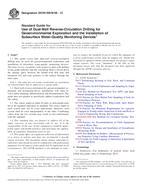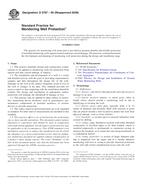We need your consent to use the individual data so that you can see information about your interests, among other things. Click "OK" to give your consent.
ASTM D5781/D5781M-13
Standard Guide for Use of Dual-Wall Reverse-Circulation Drilling for Geoenvironmental Exploration and the Installation of Subsurface Water-Quality Monitoring Devices
STANDARD published on 1.7.2013
The information about the standard:
Designation standards: ASTM D5781/D5781M-13
Note: WITHDRAWN
Publication date standards: 1.7.2013
SKU: NS-32525
The number of pages: 8
Approximate weight : 24 g (0.05 lbs)
Country: American technical standard
Category: Technical standards ASTM
The category - similar standards:
Annotation of standard text ASTM D5781/D5781M-13 :
Keywords:
down-the-hole hammer (DTH) drilling, drilling, dual-wall reverse-circulation drilling method(s), geoenvironmental exploration, groundwater, percussion-hammer drilling method, triple-wall percussion-hammer drilling method, vadose zone, ICS Number Code 73.100.30 (Equipment for drilling and mine excavation)
Additional information
| Significance and Use | ||||||||||||||||||||||
|
4.1 Dual-wall reverse-circulation drilling can be used in support of geoenvironmental exploration and for installation of subsurface water-quality monitoring devices in unconsolidated and consolidated materials. Dual-wall reverse-circulation drilling methods permit the collection of water-quality samples at any depth(s), allows the setting of temporary casing during drilling, cuttings samples can be taken continuously as circulation is maintained at all times during drilling. Other advantages of the dual-wall reverse-circulation drilling method include: (1) the capability of drilling without the introduction of any drilling fluid(s) to the subsurface; (2) maintenance of hole stability for sampling purposes and monitor-well installation/construction in poorly-indurated to unconsolidated materials. 4.1.1 The user of dual-wall reverse-circulation drilling for geoenvironmental exploration and monitoring-device installations should be cognizant of both the physical (temperature and airborne particles) and chemical (compressor lubricants and possible fluid additives) qualities of compressed air that may be used as the circulating medium. 4.2 The application of dual-wall reverse-circulation drilling to geoenvironmental exploration may involve soil or rock sampling, or in-situ soil, rock, or pore-fluid testing. 4.3 The subsurface water-quality
monitoring devices that are addressed in this guide consist
generally of a screened- or porous-intake device and riser pipe(s)
that are usually installed with a filter pack to enhance the
longevity of the intake unit, and with isolation seals and
low-permeability backfill to deter the movement of fluids or
infiltration of surface water between hydrologic units penetrated
by the borehole (see Practice D5092). Inasmuch as a piezometer is
primarily a device used for measuring subsurface hydraulic heads,
the conversion of a piezometer to a water-quality monitoring device
should be made only after consideration of the overall quality and
integrity of the installation to include the quality of materials
that will contact sampled water or gas. Both water-quality
monitoring devices and piezometers should have adequate casing
seals, annular isolation seals, and backfills to deter
communication of contaminants between hydrologic units.
1.1 This guide covers how dual-wall
reverse-circulation drilling may be used for geoenvironmental
exploration and installation of subsurface water-quality monitoring
devices. The term reverse circulation
with respect to dual-wall drilling in this guide indicates that the
circulating fluid is forced down the annular space between the
double-wall drill pipe and transports soil and rock particles to
the surface through the inner pipe.
1.2 Dual-wall reverse-circulation
for geoenvironmental exploration and monitoring-device
installations will often involve safety planning, administration,
and documentation. This guide does not purport to specifically
address exploration and site safety.
1.3 The values stated in either SI units or inch-pound units are to be regarded separately as standard. The values stated in each system may not be exact equivalents; therefore, each system shall be used independently of the other. Combining values from the two systems may result in non-conformance with the standard. 1.4 This standard does not purport to address all of the safety concerns, if any, associated with its use. It is the responsibility of the user of this standard to establish appropriate safety and health practices and determine the applicability of regulatory limitations prior to use. 1.5 This guide offers an organized collection of information or a series of options and does not recommend a specific course of action. This document cannot replace education or experience and should be used in conjunction with professional judgment. Not all aspects of this guide may be applicable in all circumstances. This ASTM standard is not intended to represent or replace the standard of care by which the adequacy of a given professional service must be judged, nor should this document be applied without consideration of a project's many unique aspects. The word “Standard” in the title of this document means only that the document has been approved through the ASTM consensus process. |
||||||||||||||||||||||
| 2. Referenced Documents | ||||||||||||||||||||||
|
Similar standards:
Historical
1.9.2012
Historical
1.4.2009
Historical
1.5.2012
Historical
1.7.2008
Historical
1.9.2012
Historical
1.11.2011
We recommend:
Technical standards updating
Do you want to make sure you use only the valid technical standards?
We can offer you a solution which will provide you a monthly overview concerning the updating of standards which you use.
Would you like to know more? Look at this page.



 ASTM D5783-95(2012)..
ASTM D5783-95(2012).. ASTM D5787-95(2009)..
ASTM D5787-95(2009).. ASTM D5850-95(2012)..
ASTM D5850-95(2012).. ASTM D6032-08
ASTM D6032-08 ASTM D6286-12
ASTM D6286-12 ASTM D6391-11
ASTM D6391-11
 Cookies
Cookies
